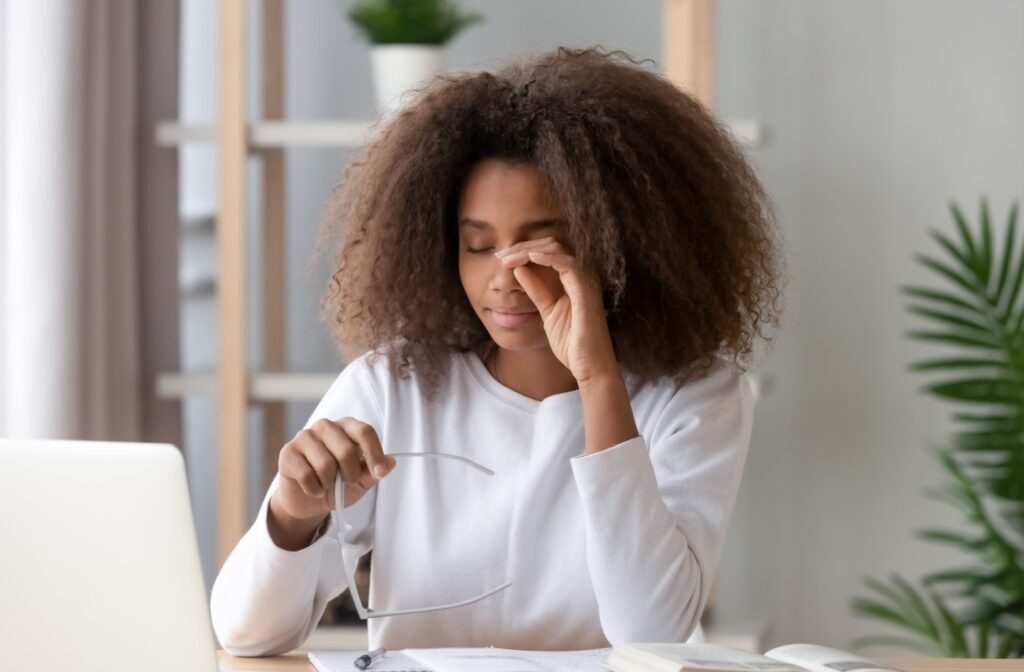Meibomian gland dysfunction (MGD) is a leading cause of dry eye and can significantly impact eye health and comfort, leading to dryness, irritation and blurred vision. While MGD may often be a chronic condition, there are effective ways to manage and treat it.
But there isn’t a catch-all answer for how long meibomian gland dysfunction lasts because it ultimately depends on the root and other contributing factors. Some people start seeing relief in a single treatment, while the condition is chronic and requires ongoing management for others.
You can do things at home to minimize your symptoms and get relief. Your eye doctor can also recommend several treatments, from medication to in-office procedures. So, the importance of involving your eye doctor can’t be overstated when it comes to getting relief from MGD.
What Is Meibomian Gland Dysfunction?
MGD is a common condition that affects the meibomian glands, which are tiny oil-producing glands located along the edges of your eyelids. These glands play a crucial role in maintaining the health of your tear film by producing oils that prevent tears from evaporating too quickly.
The tear film is disrupted when these glands become blocked or don’t function properly. This can lead to symptoms of dry eye, discomfort, and inflammation.
Understanding the Causes and Symptoms of MGD
Several factors contribute to the development of MGD, including:
- Aging: Meibomian gland function naturally declines with age, making blockages more likely
- Hormonal changes: Hormonal imbalances can affect the glands
- Chronic eye conditions: Conditions like blepharitis (eyelid inflammation) are closely related to MGD
- Environmental factors: Prolonged screen time, low humidity environments, and air pollution can exacerbate symptoms
- Medical conditions: Rosacea, allergies, and autoimmune diseases may increase the risk
Recognizing Symptoms of MGD
Common symptoms of MGD include:
- Dryness and irritation in the eyes
- Sensitivity to light
- A gritty or burning sensation
- Redness or swelling of the eyelids
- Blurred vision
- Crustiness or discharge around the edges of your eyelids
How Long Does MGD Typically Last?
The duration of MGD varies from person to person. For some, symptoms may improve within weeks of starting treatment. But MGD can be a chronic condition requiring long-term care for others—especially if there is another factor, such as an autoimmune disorder, contributing to it.
The key takeaway here is that while MGD may not vanish entirely, consistent treatment and lifestyle management can significantly reduce its impact.

Common Treatments for MGD
There isn’t a single “best” treatment for MGD, as it ultimately depends on the root of your symptoms. Fortunately, your optometrist can explore various treatment options with you.
Warm Compresses
Applying a warm compress to your eyelids can help loosen blockages in the meibomian glands. For best results, this should be a daily practice. Ask your eye doctor about special masks that make this more effective.
Lid Hygiene
Regularly cleaning your eyelids with a gentle cleanser can remove debris, bacteria, and oils that may contribute to blockages. Always use an appropriate cleaner around your eyes.
Medications
Your eye doctor may recommend various medications or over-the-counter options, depending on the severity of your symptoms. Common suggestions include:
- Artificial tears: Lubricating eye drops help alleviate the dryness and itching that often accompanies MGD
- Antibiotics: If your eye doctor suspects that a bacterial infection is contributing to your symptoms, they may prescribe antibiotics—oral or topical
- Steroid eye drops: Inflammation can contribute to the symptoms and their discomfort, so steroid eye drops can help reduce swelling and improve comfort
Advanced Procedures
There are various in-office treatments available for dry eye and MGD that your eye doctor can recommend:
- Eyelid massage devices like LipiFlow use heat and manual stimulation to unblock meibomian glands
- Intense pulsed light (IPL) therapy can improve meibomian gland performance and reduce inflammation and dry eye symptoms
Managing MGD with Lifestyle Changes
Consistently managing MGD is key to avoiding flare-ups and maintaining healthy eyes. None of these is in themselves the answer, but the following lifestyle changes can contribute to healthy, comfortable eyes.
Hydrate & Take Breaks
Drink plenty of water and stay hydrated to help your tear film remain healthy. Try reducing screen time where possible to prevent digital eye strain, which often worsens symptoms.
Adapt Your Environment
You can often control your environment to a degree. Try using a humidifier in your home, keeping windows closed during high-allergen seasons, and avoiding smoke and other airborne irritants.
Prioritize Lid Hygiene
Maintain a high degree of cleanliness regarding your eyes. Cleaning your eyelids should become a regular part of your daily routine. Always use a cleaner designed explicitly for eyelids or something gentle like baby shampoo.
Visit Your Eye Doctor Regularly
Routine eye exams ensure your treatment works effectively and allow your doctor to make necessary adjustments. Regular eye exams allow your eye doctor to review your overall eye health.
Get Relief from Your MGD Discomfort Today
If you suspect you have MGD or are struggling to manage your symptoms, now is the time to take action. Schedule an appointment with your eye doctor or explore advanced therapies that could work for you. Healthy, comfortable eyes are within reach.
Call our team at the Vision Care Centre today and book an appointment. One of our experienced eye doctors can examine your eyes and tailor a treatment plan to your situation.



